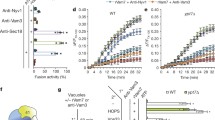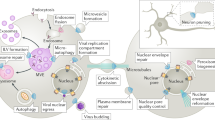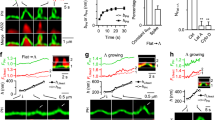Abstract
A general machinery buds and fuses transport vesicles which connect intracellular compartments with each other and allow communication with the extracellular environment. Cytoplasmic coat proteins deform membranes to bud vesicles and interact directly or indirectly with cargo molecules. Compartment-specific SNAREs (SNAP receptors) on vesicles and target membranes dock vesicles and provide a scaffolding for the general fusion machinery to initiate lipid bilayer fusion.
Similar content being viewed by others
Abbreviations
- NSF:
-
N-ethylmaleimide-sensitive fusion protein
- SNAP:
-
soluble NSF attachment protein
- SNARE:
-
SNAP receptor
- ER:
-
endoplasmic reticulum
- ARF:
-
ADP-ribosylation factor
- NEM:
-
N-ethylmaleimide
- GAP:
-
GTPase activating protein
References
Palade G. (1975) Intracellular aspects of the process of protein synthesis. Science189: 347–358
Serafini T., Stenbeck G., Brecht A., Lottspeich F., Orci L., Rothman J. E. et al. (1991) A coat subunit of Golgi-derived non-clathrin-coated vesicles with homology to the clathrincoated vesicle coat protein beta-adaptin. Nature349: 215–220
Waters M. G., Serafini T. and Rothman J. E. (1991) ‘Coatomer’: a cytosolic protein complex containing subunits of non-clathrin-coated Golgi transport vesicles. Nature349: 248–251
Serafini T., Orci L., Amherdt M., Brunner M., Kahn R. A. and Rothman J. E. (1991) ADP-ribosylation factor is a subunit of the coat of Golgi-derived COP-coated vesicles: a novel role for a GTP-binding protein. Cell67: 239–253
Brown H. A., Gutowski S., Moomaw C. R., Slaughter C. and Sternweis P. C. (1993) ADP-ribosylation factor, a small GTP-dependent regulatory protein, stimulates phospholipase D activity [see comments]. Cell75: 1137–1144
Cockcroft S., Thomas G. M., Fensome A., Geny B., Cunningham E., Gout I. et al. (1994) Phospholipase D: a downstream effector of ARF in granulocytes. Science263: 523–526
De Camilli P., Emr S. D., McPherson P. S. and Novick P. (1996) Phosphoinositides as regulators in membrane traffic. Science271: 1533–1539
Ostermann J., Orci L., Tani K., Amherdt M., Ravazzola M., Elazar Z. et al. (1993) Stepwise assembly of functionally active transport vesicles. Cell75: 1015–1025.
Tanigawa G., Orci L., Amherdt M., Ravazzola M., Helms J. B. and Rothman J. E. (1993) Hydrolysis of bound GTP by ARF protein triggers uncoating of Golgi-derived COP-coated vesicles. J. Cell. Biol.123: 1365–1371
Cukierman E., Huber I., Rotman M. and Cassel D. (1995) The ARF1 GTPase-activating protein: zinc finger motif and Golgi complex localization. Science270: 1999–2002
Makler V., Cukierman E., Rotman M., Admon A. and Cassel D. (1995) ADP-ribosylation factor-directed GTPase-activating protein: purification and partial characterization. J. Biol. Chem.270: 5232–5237
Wieland F. T., Gleason M. L., Serafini T. A. and Rothman J. E. (1987) The rate of bulk flow from the endoplasmic reticulum to the cell surface. Cell50: 289–300
Pearse B. M. (1988) Receptors compete for adaptors found in plasma membrane coated pits. Embo J.7: 3331–3336
Jackson M. R., Nilsson T. and Peterson P. A. (1990) Identification of a consensus motif for retention of transmembrane proteins in the endoplasmic reticulum. Embo J.9:3153–3162
Nilsson T., Jackson M. and Peterson P. A. (1989) Short cytoplasmic sequences serve as retention signals for transmembrane proteins in the endoplasmic reticulum. Cell58: 707–718
Schutze M. P., Peterson P. A. and Jackson M. R. (1994) An N-terminal double-arginine motif maintains type II membrane proteins in the endoplasmic reticulum. Embo J.13: 1696–1705
Cosson P. and Letourneur F. (1994) Coatomer interaction with di-lysine endoplasmic reticulum retention motifs. Science263: 1629–1631
Letourneur F., Gaynor E. C., Hennecke S., Demolliere C., Duden R., Emr S. D. et al. (1994) Coatomer is essential for retrieval of dilysine-tagged proteins to the endoplasmic reticulum. Cell79: 1199–1207
Rothman J. E. and Wieland F. T. (1996) Protein sorting by transport vesicles. Science272: 227–234
Stamnes M. A., Craighead M. W., Hoe M. H., Lampen N., Geromanos S., Tempst P. and Rothman J. E. (1995) An integral membrane component of coatomer-coated transport vesicles defines a family of proteins involved in budding. Proc. Natl. Acad. Sci. USA92: 8011–8015
Schimmoller F., Singer-Kruger B., Schroder S., Kruger U., Barlowe C. and Riezman H. (1995) The absence of Emp24p, a component of ER-derived COPII-coated vesicles, causes a defect in transport of selected proteins to the Golgi. Embo J.14: 1329–1339
Vale R. D., Schnapp B. J., Reese T. S. and Sheetz M. P. (1985) Movement of organelles along filaments dissociated from the axoplasm of the squid giant axon. Cell40: 449–454
Vale R. D., Schnapp B. J., Mitchison T., Steuer E., Reese T. S. and Sheetz M. P. (1985) Different axoplasmic proteins generate movement in opposite directions along microtubules in vitro. Cell43: 623–632
Söllner T., Whiteheart S. W., Brunner M., Erdjument-Bromage H., Geromanos S., Tempst P. et al. (1993) SNAP receptors implicated in vesicle targeting and fusion [see comments]. Nature362: 318–324
Lewis M. J. and Pelham H. R. (1996) SNARE-mediated retrograde traffic from the Golgi complex to the endoplasmic reticulum. Cell85: 205–215
Banfield D. K., Lewis M. J., Rabouille C., Warren G. and Pelham H. R. (1994) Localization of Sed5, a putative vesicle targeting molecule, to the cis-Golgi network involves both its transmembrane and cytoplasmic domains. J. Cell. Biol.127: 357–371
Jones E. W. (1977) Proteinase mutants ofSaccharomyces cerevisiae. Genetics85: 23–33
Aalto M. K., Ronne H. and Keranen S. (1993) Yeast syntaxins Sso1p and Sso2p belong to a family of related membrane proteins that function in vesicular transport. Embo J.12: 4095–4104
Hardwick K. G. and Pelham H. R. (1992) SED5 encodes a 39-kD integral membrane protein required for vesicular transport between the ER and the Golgi complex. J. Cell. Biol.119: 513–521
Banfield D. K., Lewis M. J. and Pelham H. R. (1995) A SNARE-like protein required for traffic through the Golgi complex. Nature375: 806–809
Sogaard M., Tani K., Ye R. R., Geromanos S., Tempst P., Kirchhausen T. et al. (1994) A rab protein is required for the assembly of SNARE complexes in the docking of transport vesicles. Cell78: 937–948
Protopopov V., Govindan B., Novick P. and Gerst, J. E. (1993) Homologs of the synaptobrevin/VAMP family of synaptic vesicle proteins function on the late secretory pathway inS. cerevisiae. Cell74: 855–861
Couve A. and Gerst J. E. (1994) Yeast Snc proteins complex with Sec9: functional interactions between putative SNARE proteins. J. Biol. Chem.269: 23391–23394
Novick P., Field C. and Schekman R. (1980) Identification of 23 complementation groups required for post-translational events in the yeast secretory pathway. Cell21: 205–215
Newman A. P., Shim J. and Ferro-Novick S. (1990) BET1, BOS1 and SEC22 are members of a group of interacting yeast genes required for transport from the endoplasmic reticulum to the Golgi complex. Mol. Cell. Biol.10: 3405–3414
Dascher C., Ossig R., Gallwitz D. and Schmitt H. D. (1991) Identification and structure of four yeast genes (SLY) that are able to suppress the functional loss of YPT1, a member of the RAS superfamily. Mol. Cell. Biol.11: 872–885
Bennett M. K., Garcia-Arraras J. E., Elferink L. A., Peterson K., Fleming A. M., Hazuka C. D. et al. (1993) The syntaxin family of vesicular transport receptors. Cell74: 863–873
DeBello W. M., Betz H. and Augustine G. J. (1993) Synaptotagmin and neurotransmitter release [comment]. Cell74: 947–950
Elferink L. A., Peterson M. R. and Scheller R. H. (1993) A role for synaptotagmin (p65) in regulated exocytosis. Cell72: 153–159
Geppert M., Goda Y., Hammer R. E., Li C., Rosahl T. W., Stevens C. F. et al. (1994) Synaptotagmin I: a major Ca2+ sensor for transmitter release at a central synapse. Cell79: 717–727
Südhof T. C. (1995) The synaptic vesicle cycle: a cascade of protein-protein interactions. Nature375: 645–653
Schiavo G., Gmachl M. J., Stenbeck G., Söllner, T. H. and Rothman J. E. (1995) A possible docking and fusion particle for synaptic transmission. Nature378: 733–736
Baumert M., Maycox P. R., Navone F., De Camilli P. and Jahn R. (1989) Synaptobrevin: an integral membrane protein of 18,000 daltons present in small synaptic vesicles of rat brain. Embo J.8: 379–384
Trimble W. S., Cowan D. M. and Scheller R. H. (1988) VAMP-1: a synaptic vesicle-associated integral membrane protein. Proc. Natl. Acad. Sci. USA85: 4538–4542
Oyler G. A., Higgins G. A., Hart R. A., Battenberg E., Billingsley M., Bloom F. E. et al. (1989) The identification of a novel synaptosomal-associated protein, SNAP-25, differentially expressed by neuronal subpopulations. J. Cell. Biol.109: 3039–3052
Bennett M. K., Calakos N. and Scheller R. H. (1992) Syntaxin: a synaptic protein implicated in docking of synaptic vesicles at presynaptic active zones. Science257: 255–259
Hunt J. M., Bommert K., Charlton M. P., Kistner A., Habermann E., Augustine G. J. et al. (1994) A post-docking role for synaptobrevin in synaptic vesicle fusion. Neuron12: 1269–1279
Broadie K., Prokop A., Bellen H. J., O'Kane C. J., Schulze K. L. and Sweeney S. T. (1995) Syntaxin and synaptobrevin function downstream of vesicle docking inDrosophila. Neuron15: 663–673
Sweeney S. T., Broadie K., Keane J., Niemann H. and O'Kane C. J. (1995) Targeted expression of tetanus toxin light chain inDrosophila specifically eliminates synaptic transmission and causes behavioral defects. Neuron14: 341–351
Pevsner J., Hsu S. C., Braun J. E., Calakos N., Ting A. E., Bennett M. K. et al. (1994) Specificity and regulation of a synaptic vesicle docking complex. Neuron13: 353–361
Harrison S. D., Broadie K., van de Goor J. and Rubin G. M. (1994) Mutations in theDrosophila Rop gene suggest a function in general secretion and synaptic transmission. Neuron13: 555–566
Edelmann L., Hanson P. I., Chapman E. R. and Jahn R. (1995) Synaptobrevin binding to synaptophysin: a potential mechanism for controlling the exocytotic fusion machine. Embo J.14: 224–231
Leveque C., Hoshino T., David P., Shoji-Kasai, Y., Leys K., Omori A. et al. (1992) The synaptic vesicle protein synaptotagmin associates with calcium channels and is a putative Lambert-Eaton myasthenic syndrome antigen. Proc. Natl. Acad. Sci. USA89: 3625–3629
Yoshida A., Oho C., Omori A., Kuwahara R., Ito, T. and Takahashi M. (1992) HPC-1 is associated with synaptotagmin and omega-conotoxin receptor. J. Biol. Chem.267: 24925–24928
Malhotra V., Orci L., Glick B. S., Block M. R. and Rothman J. E. (1988) Role of anN-ethylmaleimide-sensitive transport component in promoting fusion of transport vesicles with cisternae of the Golgi stack. Cell54: 221–227
Block M. R., Glick B. S., Wilcox C. A., Wieland F. T., Rothman J. E., Malhotra V. et al. (1988) Purification of anN-ethylmaleimide-sensitive protein catalyzing vesicular transport. Proc. Natl. Acad. Sci. USA85: 7852–7856
Clary D. O., Griff I. C. and Rothman J. E. (1990) SNAPs, a family of NSF attachment proteins involved in intracellular membrane fusion in animals and yeast. Cell61: 709–721
Whiteheart S. W., Griff I. C., Brunner M., Clary D. O., Mayer T., Buhrow S. A. et al. (1993) SNAP family of NSF attachment proteins includes a brain-specific isoform [see comments]. Nature362: 353–355
Beckers C. J., Block M. R., Glick B. S., Rothman J. E. and Balch W. E. (1989) Vesicular transport between the endoplasmic reticulum and the Golgi stack requires the NEM-sensitive fusion protein. Nature339: 397–398
Diaz R., Mayorga L. S., Weidman P. J., Rothman, J. E. and Stahl P. D. (1989) Vesicle fusion following receptor-mediated endocytosis requires a protein active in Golgi transport. Nature339: 398–400
Graham T. R. and Emr S. D. (1991) Compartmental organization of Golgi-specific protein modification and vacuolar protein sorting events defined in a yeast sec18 (NSF) mutant. J. Cell. Biol.114: 207–218
Orci L., Malhotra V., Amherdt M., Serafini T. and Rothman J. E. (1989) Dissection of a single round of vesicular transport: sequential intermediates for intercisternal movement in the Golgi stack. Cell56: 357–368
Pallanck L., Ordway R. W. and Ganetzky B. (1995) ADrosophila NSF mutant [letter]. Nature376: 25
Wilson D. W., Wilcox C. A., Flynn G. C., Chen E., Kuang W. J., Henzel W. J. (1989) A fusion protein required for vesicle-mediated transport in both mammalian cells and yeast. Nature339: 355–359
Kaiser C. A. and Schekman R. (1990) Distinct sets of SEC genes govern transport vesicle formation and fusion early in the secretory pathway. Cell61: 723–733
Weidman P. J., Melancon P., Block M. R. and Rothman J. E. (1989) Binding of anN-ethylmaleimide-sensitive fusion protein to Golgi membranes requires both a soluble protein(s) and an integral membrane receptor. J. Cell. Biol.108: 1589–1596
Söllner T., Bennett M. K., Whiteheart S. W., Scheller R. H. and Rothman J. E. (1993) A protein assembly-disassembly pathway in vitro that may correspond to sequential steps of synaptic vesicle docking, activation and fusion. Cell75: 409–418
Hayashi T., McMahon H., Yamasaki S., Binz T., Hata Y., Sudhof T. C. et al. (1994) Synaptic vesicle membrane fusion complex: action of clostridial neurotoxins on assembly. Embo J.13: 5051–5061
Chapman E. R., An S., Barton N. and Jahn R. (1994) SNAP-25, a t-SNARE which binds to both syntaxin and synaptobrevin via domains that may form coiled coils. J. Biol. Chem.269: 27427–27432
Author information
Authors and Affiliations
Rights and permissions
About this article
Cite this article
Söllner, T.H., Rothman, J.E. Molecular machinery mediating vesicle budding, docking and fusion. Experientia 52, 1021–1025 (1996). https://doi.org/10.1007/BF01952097
Issue Date:
DOI: https://doi.org/10.1007/BF01952097




